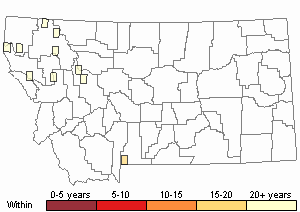View in other NatureServe Network Field Guides
NatureServe
Montana
Utah
Wyoming
Idaho
Wisconsin
British Columbia
South Carolina
Yukon
California
New York
A Working Man's Moss - Kindbergia praelonga
Other Names:
Eurhynchium praelongum, Eurhynchium praelongum var. stokesii
General Description
Plants: Pleurocarpous, growing in expanding mats (Lawton 1971), soft to slightly firm, somewhat dull (Crum and Anderson et al. 1981), green, seldom green with yellow tones. Stems 3-10 cm in length, not noticeably feathery (FNA 2014), creeping or bowing, frequently stoloniferous (Lawton 1971) with stems having small (differentiated) leaves and rhizoid-bearing tips (Crum and Anderson et al. 1981), often the main stem of limited growth and dividing into branches (FNA 2014), possessing a central strand (FNA 2014); pseudoparaphyllia sometimes present (Lawton 1971); axillary hairs with a length of 4-5 cells. Branches seldom reaching 20 mm, the pinnate branches frequently forking into secondary branches (FNA 2014).
Stem Leaves: Spreading to about 45 degrees when dry, when moist (Crum and Anderson et al. 1981) typically spreading to 90 degrees (Lawton 1971), widely deltoid with a heart-shaped base, 0.7-1.4 mm in length, sometimes reaching 1.2 mm in width; base widely extending down the stem somewhat far; acumen lance-shaped (FNA 2014) and frequently twisted (Crum and Anderson et al. 1981); leaf edges flat, saw-toothed to or almost to the leaf bottom; costa often extending beyond mid-leaf (Lawton 1971), wide, nearly always with a dorsal spine at the end (FNA 2014).
Branch Leaves: Smaller and more slender than the stem leaves (FNA 2014), spreading to about 45 degrees (Lawton 1971), lance-shaped, occasionally with ovate tendencies, 1-2 mm in length (FNA 2014); base extending down the stem (Lawton 1971); dorsal surfaces of the costa and lamina more strongly dentate than in the stem leaves (FNA 2014), 3/4 or more of the leaf length. Stoloniferous leaves small and smooth or nearly so (Lawton 1971).
Leaf Cells: Stem leaf alar cells often transparent, short, and medial laminal cells longer above than at the base, occasionally with pitted walls. Branch leaf apical cells with length twice that of the width or more; alar cells square (Lawton 1971).
Diagnostic Characteristics
The similar Sciuro-hypnum starkei is autoicous (with sporophytes produced frequently) rather than dioicous, and often has a cone-shaped rather than long-beaked operculum as in Eurhynchium praelongum (FNA 2014).
Range Comments
North American Range
Canada: BC; USA: AK, WA to CA, also ID, MT and NV; Mexico (FNA 2014). Known in Montana from Flathead, Glacier, Lake, Lincoln, Lewis and Clark, and Sanders Counties (Elliott and Pipp 2016).
Observations in Montana Natural Heritage Program Database
Number of Observations: 17
(Click on the following maps and charts to see full sized version)
Map Help and Descriptions
Relative Density

Recency



 (Observations spanning multiple months or years are excluded from time charts)
(Observations spanning multiple months or years are excluded from time charts)
Habitat
Soil, stones, and decaying wood in damp (Crum and Anderson et al. 1981) to wetter areas in or close to forests. Ranging from low-lying areas to 8530 feet elevation (FNA 2014).
Reproductive Characteristics
Dioicous (FNA 2014), with reproductive parts occurring on the stems. Perigonial leaves to 1.2 mm in length. Perichaetial leaves to 4 mm, the exterior leaves spreading about 90 degrees, the interior ones more upright; apices thread-like and finely saw-toothed (Lawton 1971). Seta very coarse, 15-25 mm tall, russet. Capsule russet, bowed, tilted to level (FNA 2014) or drooping (Crum and Anderson et al. 1981), brown, the theca 2-2.5 mm in length (Lawton 1971); operculum beak long (FNA 2014); peristome allowing capsule mouth to open in low humidity. Calyptra lacking hair (FNA 2014).
Stewardship Responsibility
References
- Literature Cited AboveLegend:
 View Online Publication
View Online Publication Crum, H.A. and L.E. Anderson. 1981. Mosses of Eastern North America. 2 volumes. Columbia University Press, New York. 1328 pp.
Crum, H.A. and L.E. Anderson. 1981. Mosses of Eastern North America. 2 volumes. Columbia University Press, New York. 1328 pp. Elliott, J.C. and A.K. Pipp. 2018. A Checklist of Montana Mosses (1880-2018). Updated 3 January, 2020. Montana Natural Heritage Program, Helena, Montana. 73 pp.
Elliott, J.C. and A.K. Pipp. 2018. A Checklist of Montana Mosses (1880-2018). Updated 3 January, 2020. Montana Natural Heritage Program, Helena, Montana. 73 pp. Flora of North America Editorial Committee, eds. 2014. Flora of North America North of Mexico. Volume 28. Bryophytes: Mosses, Part 2. Oxford University Press, Inc., NY. xxi + 702 pp.
Flora of North America Editorial Committee, eds. 2014. Flora of North America North of Mexico. Volume 28. Bryophytes: Mosses, Part 2. Oxford University Press, Inc., NY. xxi + 702 pp. Lawton, E. 1971. Moss Flora of the Pacific Northwest. Hattori Botanical Laboratory. Japan: Yamabuki-cho, Shinjuku-ku, Tokyo. 362 pages plus appendices.
Lawton, E. 1971. Moss Flora of the Pacific Northwest. Hattori Botanical Laboratory. Japan: Yamabuki-cho, Shinjuku-ku, Tokyo. 362 pages plus appendices.
- Additional ReferencesLegend:
 View Online Publication
View Online Publication
Do you know of a citation we're missing? Elliot, J. C. 1993. Second checklist of Montana mosses. Unpublished report. U.S. Forest Service, Region 1. Missoula, MT. 45 pp.
Elliot, J. C. 1993. Second checklist of Montana mosses. Unpublished report. U.S. Forest Service, Region 1. Missoula, MT. 45 pp. Lawton, E. 1971. Keys for the Identification of the Mosses on the Pacific Northwest. Reprinted from 'Moss Flora of the Pacific Northwest'. Published as Supplement No. 2 of the Journal of the Hattori Botanical Laboratory. Nichinan, Miyazaki, Japan. 66 pp.
Lawton, E. 1971. Keys for the Identification of the Mosses on the Pacific Northwest. Reprinted from 'Moss Flora of the Pacific Northwest'. Published as Supplement No. 2 of the Journal of the Hattori Botanical Laboratory. Nichinan, Miyazaki, Japan. 66 pp. Malcolm, B., N. Malcolm, J. Shevock, and D. Norris. 2009. California Mosses. Nelson, New Zealand: Micro-Optics Press. 430 pp.
Malcolm, B., N. Malcolm, J. Shevock, and D. Norris. 2009. California Mosses. Nelson, New Zealand: Micro-Optics Press. 430 pp. Vitt, D. J. Marsh, and R. Bovey. 1988. Mosses, Lichens & Ferns of Northwest North America. Seattle, WA: University of Washington Press. 296 p.
Vitt, D. J. Marsh, and R. Bovey. 1988. Mosses, Lichens & Ferns of Northwest North America. Seattle, WA: University of Washington Press. 296 p.
- Web Search Engines for Articles on "A Working Man's Moss"





